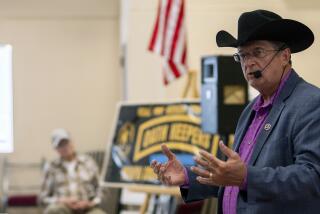Missile Defense System Fails Test
The first test of a national missile defense system in two years failed Wednesday when the “kill vehicle” never got off the ground.
If the $85-million test had succeeded, the Bush administration was expected to use it as proof of the viability of the system. Instead, the failure gives critics new grounds to be skeptical of the technically challenging and costly program.
The missile interceptor is intended to be part of a multi-layered system meant to protect the nation from a missile attack.
It was the latest in a series of setbacks for the program, which has been ongoing since the Reagan administration and which President Bush pushed to the forefront of his national security plans in May 2001. His goal was to have a limited system in place by the end of this year.
Officials said Wednesday that the inability to complete the test did not represent a failure of the system, but only a technical mishap that could be remedied.
But the developments made it clear that debate would continue over the feasibility of a system that by some accounts has cost $130 billion and is scheduled to tally $50 billion more over the next five years.
Analysts said that in an era of tight budgets and a reduction in the threat of ballistic missile attacks on the United States, it was increasingly likely that congressional and other critics of the antimissile program would seek to shift money away from it.
Much of the design work on the interceptor has been done in California.
Chicago-based Boeing Co. is the lead contractor and has 500 engineers working on the project in Anaheim. Raytheon Co. built many of the sensors, radar and targeting equipment at its electronic systems unit in El Segundo.
Wednesday’s two-part test called for the interceptor to be launched from the Ronald Reagan Test Site on the Kwajalein Atoll in the Central Pacific and a target missile to be fired from Kodiak, Alaska. If successful, the so-called kill vehicle would pass close enough to the target rocket to destroy it.
The target missile was fired at 12:45 a.m. EST without event, but the interceptor never left its silo. Twenty-three seconds before it was to launch, a safety sensor detected an unknown problem and shut the system down, said Richard Lehner, a spokesman for the Pentagon’s Missile Defense Agency.
“It means that the president is not going to fulfill his promise to open a facility in 2004. This was his last chance,” said Joseph Cirincione of the Carnegie Foundation, a nonprofit organization.
“The performance of these systems cannot support these inflated budgets. And as budgetary pressures grow, military leaders in the Pentagon are going to have their knives out to slice a little piece here or there off that program.”
Lehner disputed the suggestion that the exercise had failed, saying it simply was not completed.
“We weren’t able to complete the test that we had planned,” Lehner said. “I definitely wouldn’t categorize it as a setback of any kind. The test had been planned for a while so it’s a disappointment for those of us who were working on it. We will isolate the anomaly and fix it.”
The missile defense system is based on a concept introduced by President Reagan, and from almost the beginning referred to as “Star Wars.” When Bush pushed the proposal to the forefront at the beginning of his presidency, it was met with resistance at home and abroad.
At the time, Defense Secretary Donald H. Rumsfeld acknowledged that more research would be needed to make the system work, but called criticisms of the technology a “red herring.”
“We have no intention of deploying something that doesn’t work, but what the definition of ‘work’ is, is terribly important,” Rumsfeld said then on CBS’ “Face the Nation.”
As envisioned, the system -- promoted by some supporters as an answer to the threat of a missile attack from North Korea -- would rely on interceptors based at Vandenburg Air Force Base and Fort Greely, Alaska.
Testing using an interceptor began in October 1999.
Wednesday’s test, which had been postponed numerous times, including more than once this month, was the first in two years. It was also the first in which the interceptor was to use the same Boeing booster rocket scheduled for use in the completed system.
In previous tests, the interceptors struck five of eight targets, although critics challenged the way the tests were conducted.
While the latest test sought to get the kill vehicle near the target rocket, the most recent previous test was designed to ram into a mock warhead. That trial, on Dec. 11, 2002, failed when the warhead did not separate from its booster rocket.
The next test is scheduled for early next year.
“Here is a system that is designed to defend the country that hasn’t been tested for two years, and this test and the most previous test were both failures,” said John Isaacs, president of the Council for a Livable World, a Washington-based arms control group.
“I see no problem in trying some basic research and conducting these tests, but the whole idea of trying to declare a system operational in 2004, I think, is a mistake. The system is clearly not ready for prime time.”
More to Read
Sign up for Essential California
The most important California stories and recommendations in your inbox every morning.
You may occasionally receive promotional content from the Los Angeles Times.










